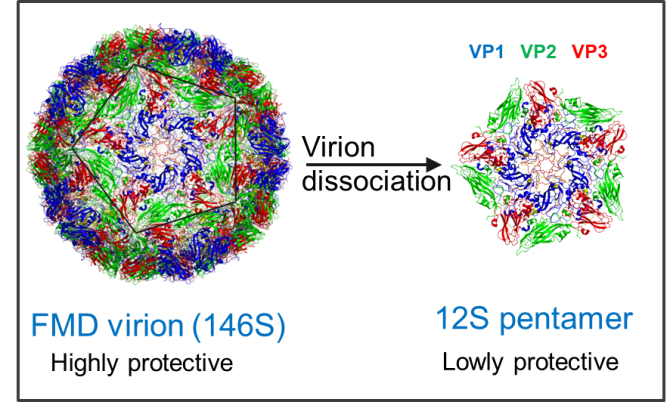
News
Structural changes in FMD virion particle 12S explain loss of immunogenicity
Foot-and-mouth disease (FMD) virions (146S) readily dissociates into stable pentamers (12S). Research from Haozhou Li of Wageningen University & Research shows that these dissociated particles are as efficient in inducing antibody response as the 146S virions. However, most antibodies induced by 12S particles do not neutralize the FMD virus. Li proved this lower immunogenicity is caused by alterations in the 12S particle structure. “This information is crucial knowledge for the optimisation of FMD vaccines”, says Michiel Harmsen of Wageningen Bioveterinary Research (WBVR), one of the co-authors of the publication in Nature Communications.
Foot-and-mouth disease (FMD) is a contagious viral disease that affects cloven-hoofed animals. The disease is caused by a picorna virus and can spread very rapidly. FMD virions (146S particles) readily dissociate into stable pentameric degradation products, also known as 12S particles. These 12S pentamers induce much lower neutralizing antibody responses. This is known already for over 30 years. However, the molecular basis of this compromised immunogenicity remained an enigma.
Structure
Haozhou Li*, PhD researcher at Wageningen University & Research, compared the antigenicity, humoral immunogenicity and 3D-structures of intact virions and 12S pentamers. For many other viruses it was shown that a reduced repetitiveness of epitopes causes a reduced immunogenicity. Li showed that this proves not the case for FMDV. The 12S particles were as efficient as 146S particles in inducing overall antibody responses, despite the higher repetition of epitopes on 146S (60-fold) as compared to 12S (5-fold). Most of the antibodies induced by 12S do not neutralize FMD virus due to the fact that dissociation of 146S into 12S particles leads to structural alteration and destruction of multiple epitopes. Thus, altered 3D structures prohibit antibodies induced by 12S to bind to 146S particles.

Vaccine quality
The findings of Li are relevant for improving FMD vaccines. Such vaccines consist of full FMD virions emulsified with adjuvant. Vaccine potency is dependent on the content of 146S particles. WBVR has a long track record in isolation of single-domain antibodies against FMDV that are specific for intact (146S) or degraded (12S) FMDV particles. These prove to be valuable tools for evaluation of vaccine quality that are used world-wide by several groups. These single-domain antibodies now also helped elucidating the molecular basis of the compromised protective immunogenicity of 12S particles.
Read here the full publication in Nature Communications.
Comments of a reviewer on the paper in Nature Communication:
This is a comprehensive and compelling study, it includes several first ever discoveries for the field of FMDV and picornaviruses including the explanation of a long-standing but unexplained dogma. I think this will be a highly important study for the field of FMDV structure and antigenicity. The paper is well written and I enjoyed reading it. Excellent work. Thank you.